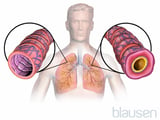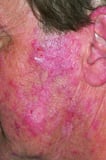what happens to the functioning of the gland in the disorder Cushings syndrome
In Cushing syndrome, the level of corticosteroids is excessive, normally due to taking corticosteroid drugs or overproduction by the adrenal glands.
-
Cushing syndrome usually results from taking corticosteroids to treat a medical disorder or from a tumor in the pituitary or adrenal gland that causes the adrenal glands to produce excessive corticosteroids.
-
Cushing syndrome tin can also effect from tumors in other locations (such every bit the lungs).
-
People with Cushing syndrome usually develop excessive fat throughout the torso and have a large, circular face and sparse skin.
-
Doctors mensurate the level of cortisol and do other tests to detect Cushing syndrome.
-
Surgery or radiation therapy is often needed to remove a tumor.
Sometimes a noncancerous tumor (adenoma) develops in the adrenal glands, which causes them to overproduce corticosteroids. Adrenal adenomas are extremely common. Most 10% of all people have them by the historic period of 70. Only a small fraction of adenomas produce backlog hormone, withal. Cancerous tumors of the adrenal glands are very rare, but some of them as well produce excess hormone.
Cushing syndrome can likewise develop in people who must take large doses of corticosteroids (such as prednisone or dexamethasone) because of a serious medical condition. Corticosteroids are often used to treat many inflammatory, allergic Overview of Allergic Reactions Allergic reactions (hypersensitivity reactions) are inappropriate responses of the allowed system to a unremarkably harmless substance. Usually, allergies brand people sneeze; the eyes water and itch... read more  , and autoimmune Autoimmune Disorders An autoimmune disorder is a malfunction of the trunk'due south allowed system that causes the body to attack its own tissues. What triggers autoimmune disorders is non known. Symptoms vary depending... read more disorders. Common examples include asthma Asthma Asthma is a condition in which the airways narrow—commonly reversibly—in response to certain stimuli. Cough, wheezing, and shortness of breath that occur in response to specific triggers are... read more than
, and autoimmune Autoimmune Disorders An autoimmune disorder is a malfunction of the trunk'due south allowed system that causes the body to attack its own tissues. What triggers autoimmune disorders is non known. Symptoms vary depending... read more disorders. Common examples include asthma Asthma Asthma is a condition in which the airways narrow—commonly reversibly—in response to certain stimuli. Cough, wheezing, and shortness of breath that occur in response to specific triggers are... read more than  , rheumatoid arthritis Rheumatoid Arthritis (RA) Rheumatoid arthritis is an inflammatory arthritis in which joints, usually including those of the hands and anxiety, are inflamed, resulting in swelling, hurting, and often devastation of joints.... read more
, rheumatoid arthritis Rheumatoid Arthritis (RA) Rheumatoid arthritis is an inflammatory arthritis in which joints, usually including those of the hands and anxiety, are inflamed, resulting in swelling, hurting, and often devastation of joints.... read more  , systemic lupus erythematosus Systemic Lupus Erythematosus (SLE) Systemic lupus erythematosus is a chronic autoimmune inflammatory connective tissue disorder that can involve joints, kidneys, skin, mucous membranes, and blood vessel walls. Issues in the... read more
, systemic lupus erythematosus Systemic Lupus Erythematosus (SLE) Systemic lupus erythematosus is a chronic autoimmune inflammatory connective tissue disorder that can involve joints, kidneys, skin, mucous membranes, and blood vessel walls. Issues in the... read more  , many skin disorders, and numerous other conditions. Those who must take large doses have the aforementioned symptoms every bit those who produce too much of the hormone. The symptoms can occasionally occur even if the corticosteroids are inhaled, equally for asthma Asthma Asthma is a condition in which the airways narrow—usually reversibly—in response to sure stimuli. Coughing, wheezing, and shortness of jiff that occur in response to specific triggers are... read more
, many skin disorders, and numerous other conditions. Those who must take large doses have the aforementioned symptoms every bit those who produce too much of the hormone. The symptoms can occasionally occur even if the corticosteroids are inhaled, equally for asthma Asthma Asthma is a condition in which the airways narrow—usually reversibly—in response to sure stimuli. Coughing, wheezing, and shortness of jiff that occur in response to specific triggers are... read more  , or are used topically for a skin condition.
, or are used topically for a skin condition.
In addition to causing Cushing syndrome, taking large doses of corticosteroids also can suppress the function of the adrenal glands. This suppression occurs considering corticosteroids signal the hypothalamus and pituitary gland to cease producing the hormones that normally stimulate adrenal role. Thus, if the person abruptly stops taking corticosteroids, the torso cannot restore adrenal role quickly enough, and temporary adrenal insufficiency (a condition similar to Addison affliction Addison Illness In Addison disease, the adrenal glands are underactive, resulting in a deficiency of adrenal hormones. Addison disease may be caused by an autoimmune reaction, cancer, an infection, or some... read more than  ) results. Likewise, when stress occurs, the trunk is not able to stimulate production of the additional corticosteroids that are needed.
) results. Likewise, when stress occurs, the trunk is not able to stimulate production of the additional corticosteroids that are needed.
Therefore, doctors never stop the utilise of corticosteroids abruptly if people have been taking them for more than than 2 or iii weeks. Instead, doctors gradually reduce (taper) the dose over weeks and sometimes months.
Too, the dose of corticosteroids may need to be increased in people who become ill or otherwise severely stressed while taking corticosteroids. Corticosteroid use may demand to be resumed in people who become ill or otherwise severely stressed within weeks of having the corticosteroid tapered and stopped.
Cushing disease is a term given specifically to Cushing syndrome acquired by overstimulation of the adrenal glands, usually considering of a pituitary tumor Enlargement of the Pituitary Gland Enlargement of the pituitary gland is ordinarily due to a tumor but may be due to bleeding into the gland or involvement by some other illness, such equally tuberculosis or sarcoidosis. In some cases... read more . In this disorder, the adrenal glands are overactive because the pituitary gland is overstimulating them, and non because the adrenal glands are abnormal. Symptoms of Cushing disease are similar to those of Cushing syndrome. Cushing disease is diagnosed past blood tests, or sometimes besides with tests of urine and saliva. Cushing disease is treated with surgery or radiations to remove the pituitary tumor. If removal of the pituitary tumor can't be done or is unsuccessful, the adrenal glands tin can exist removed surgically, or drugs tin be given to reduce corticotropin production or block the production or effects of the backlog cortisol on tissues.
Corticosteroids modify the corporeality and distribution of body fatty. Excessive fatty develops throughout the torso and may exist particularly noticeable at the tiptop of the back (sometimes called a buffalo hump). A person with Cushing syndrome normally has a big, round face (moon face). The arms and legs are normally slender in proportion to the thickened trunk. Muscles lose their bulk, leading to weakness. The skin becomes thin, bruises easily, and heals poorly when hobbling or cut. Purple streaks that look like stretch marks (striae) may develop over the abdomen and breast. People with Cushing syndrome tend to tire easily.
Over fourth dimension, high corticosteroid levels heighten the blood pressure (hypertension Loftier Claret Force per unit area High blood pressure (hypertension) is persistently loftier pressure level in the arteries. Oft no crusade for high blood pressure can be identified, merely sometimes information technology occurs as a event of an underlying... read more  ), weaken bones (osteoporosis Osteoporosis Osteoporosis is a status in which a decrease in the density of bones weakens the bones, making breaks (fractures) probable. Crumbling, estrogen deficiency, low vitamin D or calcium intake, and... read more
), weaken bones (osteoporosis Osteoporosis Osteoporosis is a status in which a decrease in the density of bones weakens the bones, making breaks (fractures) probable. Crumbling, estrogen deficiency, low vitamin D or calcium intake, and... read more  ), and diminish resistance to infections. The risk of developing kidney stones and diabetes is increased, and mental disturbances, including depression and hallucinations, may occur. Women usually take an irregular menstrual cycle. Children with Cushing syndrome grow slowly and remain short. In some people, the adrenal glands besides produce big amounts of male sexual practice hormones ( testosterone and similar hormones), leading to increased facial and body pilus, and balding in women.
), and diminish resistance to infections. The risk of developing kidney stones and diabetes is increased, and mental disturbances, including depression and hallucinations, may occur. Women usually take an irregular menstrual cycle. Children with Cushing syndrome grow slowly and remain short. In some people, the adrenal glands besides produce big amounts of male sexual practice hormones ( testosterone and similar hormones), leading to increased facial and body pilus, and balding in women.
-
Mensurate the level of cortisol in the urine, saliva, and/or claret
-
Sometimes other blood and imaging tests
When doctors suspect Cushing syndrome, they measure the level of cortisol, the principal corticosteroid hormone. Ordinarily, cortisol levels are high in the morn and lower late in the twenty-four hours. In people who have Cushing syndrome, cortisol levels are normally very loftier throughout the day. Cortisol levels may be checked by testing the urine, the saliva, or the blood.
If the cortisol levels are high, doctors may recommend a dexamethasone suppression test in which doctors give a dose of dexamethasone at nighttime or over several days and so measure the level of cortisol in the morn. Dexamethasone usually suppresses the secretion of corticotropin past the pituitary gland and should pb to suppression of cortisol secretion by the adrenal glands. If Cushing syndrome is acquired by also much pituitary stimulation (Cushing disease), the blood level of cortisol will fall to some extent, although non every bit much every bit in people who do non have Cushing syndrome. A high corticotropin level further suggests overstimulation of the adrenal gland past the pituitary.
If Cushing syndrome has some other crusade, the level of cortisol volition remain high afterwards giving dexamethasone. If a tumor in the adrenal produces as well much cortisol, the level of corticotropin from the pituitary is already suppressed, and dexamethasone does not decrease the blood level of cortisol. Sometimes, other types of tumors elsewhere in the torso produce corticotropin-similar substances that stimulate the adrenal to produce excess cortisol, merely this stimulation is not suppressed past dexamethasone.
Imaging tests may be needed to determine the exact cause, including a computed tomography (CT) or magnetic resonance imaging (MRI) browse of the pituitary or adrenal glands and a chest x-ray or CT scan of the lungs or the abdomen. Nevertheless, these tests may occasionally fail to find the tumor.
When overproduction of corticotropin is thought to be the crusade, blood samples may sometimes need to be taken from the veins that drain the pituitary to run into if that is the source.
-
Nutrition high in protein and potassium
-
Drugs that decrease cortisol levels or cake the effects of cortisol
-
Surgery or radiation therapy
Handling depends on whether the trouble is in the adrenal glands, the pituitary gland, or elsewhere.
If the trouble is caused by taking corticosteroid drugs, doctors weigh the benefit of the drug against the harm of having Cushing syndrome. Some people need to continue taking the drug. If not, doctors gradually reduce (taper) the dose over weeks and sometimes months. During the tapering, the dose may need to be increased if people get ill or otherwise severely physically stressed. Fifty-fifty for weeks to months after corticosteroids accept been stopped, people who become ill may need to resume taking the drug because their adrenal glands have not fully recovered from suppression past the corticosteroids.
The starting time stride people tin can take in the handling of Cushing syndrome is to support their general condition by post-obit a diet that is high in protein and potassium. Sometimes, drugs that increase potassium or lower claret glucose (sugar) levels are necessary. Any increase in claret pressure needs to be treated, and such patients are too at increased risk of blood clots in their veins, so blood thinners may be used. These patients are also especially liable to infections which may be life-threatening.
Surgery or radiation therapy may be needed to remove or destroy a pituitary tumor. If bachelor, proton beam therapy can be used.
Tumors of the adrenal glands (unremarkably adenomas) can ofttimes be removed surgically. Both adrenal glands may have to exist removed if these treatments are not effective, if a tumor is present in both adrenal glands, or if no tumor is present. People who have both adrenal glands removed, and many people who have part of their adrenal glands removed, must take corticosteroids for life.
Tumors outside the pituitary and adrenal glands that secrete excess hormones are usually surgically removed.
Source: https://www.msdmanuals.com/home/hormonal-and-metabolic-disorders/adrenal-gland-disorders/cushing-syndrome
Post a Comment for "what happens to the functioning of the gland in the disorder Cushings syndrome"